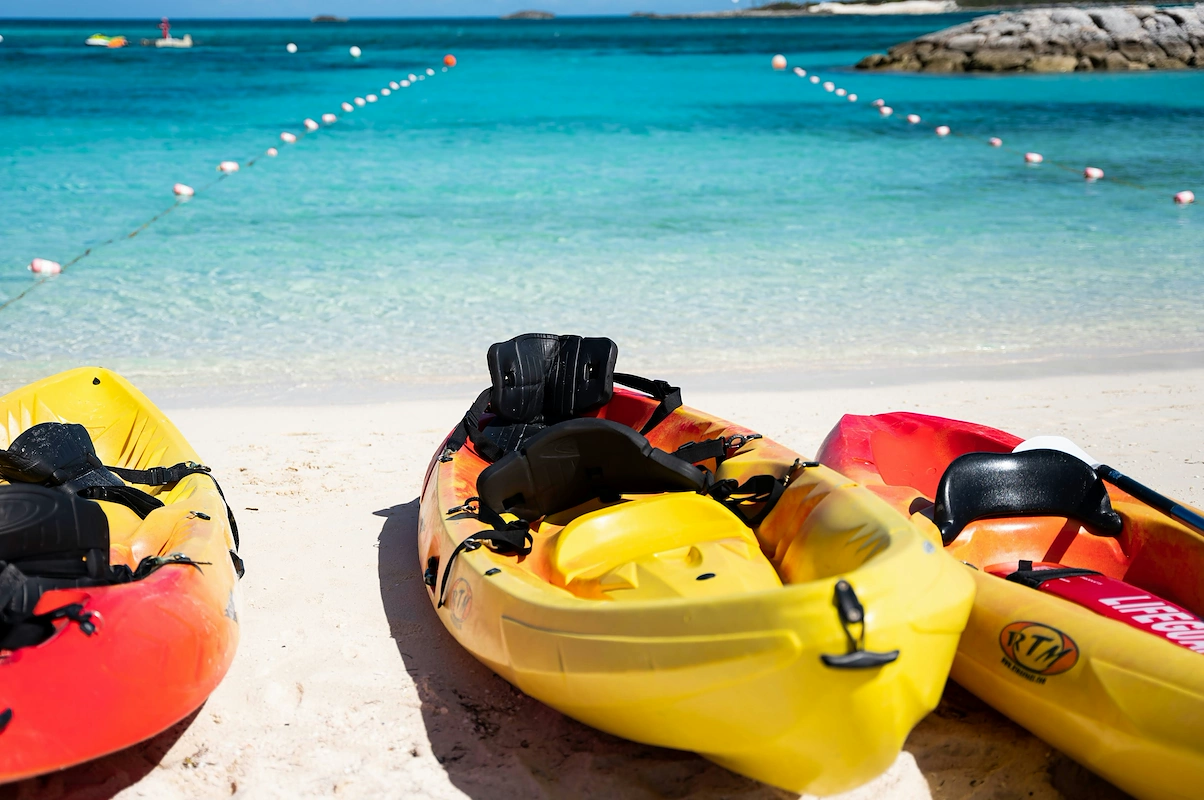A boat rental business can be a rewarding venture, blending a love for the open water with sharp business acumen. With the market valued in the billions, there's consistent demand for boat rentals from tourists, fishing groups, and families looking for a day of fun.
This guide will take you through the practical steps of validating your business concept, securing funding, obtaining the right permits, and building your fleet to help you launch a successful boat rental business in the U.S.
Step 1: Create your business plan and validate it
Gauge local demand
Start by visiting local marinas and waterfronts. Talk to harbormasters about which boat types are most requested and observe the demographics of people on the water. Local tourism boards often publish visitor data that can help you identify your target audience and peak seasons.
Analyze your competition
Use Google Maps to identify every boat rental business in your target area. Create a simple spreadsheet to track their fleet size, boat types, hourly and daily rates, and online reviews. Many new owners just copy pricing, but you should look for gaps they are not serving.
Estimate your startup costs
Mapping out your finances helps you set realistic goals. A significant portion of your initial investment will go toward your fleet and operational costs. Here is a typical breakdown for a single boat operation.
- Used Boat (20-24 ft): $25,000 - $75,000
- Commercial Marine Insurance: $2,000 - $5,000 annually per boat
- Dock or Slip Fees: $3,000 - $12,000 annually
- Business Licensing & Permits: $500 - $2,000
Here are 4 immediate steps to take:
- Visit two local marinas to survey popular boat types.
- Create a spreadsheet comparing the pricing and fleets of three local competitors.
- Get an initial insurance quote from an agent who specializes in marine businesses.
- Draft a preliminary budget with estimated costs for one boat, insurance, and one year of docking.
Step 2: Set up your legal and licensing framework
Choose your business structure
You might want to consider forming a Limited Liability Company (LLC). It protects your personal assets if the business is sued and offers simpler pass-through taxation, which avoids the double taxation of a C-Corporation. This structure is a popular choice for new rental businesses.
Secure federal, state, and local permits
With your business entity chosen, you can now pursue the necessary permits. The process involves federal, state, and local agencies. A detail many new owners miss is that an LLC does not replace the need for robust commercial insurance, which we covered in step one.
The U.S. Coast Guard (USCG) sets federal rules. If you plan to offer captained charters, you will need an Operator of Uninspected Passenger Vessels (OUPV) license. The course costs about $800 and takes several weeks to complete, so it is wise to plan ahead.
On the state level, your Department of Natural Resources (DNR) dictates boater safety requirements for renters. Locally, you will need a general business license from your city or county, which typically costs $50-$150 annually and can be issued in a few business days.
Here are 4 immediate steps to take:
- File for an LLC with your state’s Secretary of State office.
- Contact your state’s DNR to get the exact boater education rules for renters.
- Inquire with your city clerk about the application for a local business license.
- Research USCG-approved OUPV courses if you will offer captained charters.
Step 3: Secure your insurance and manage risk
Understand your insurance needs
Your LLC offers some protection, but commercial marine insurance is your main defense. This policy covers liability from accidents or injuries on the water. Expect to need at least $1 million in coverage, with annual premiums between $2,000 and $5,000 per boat.
In addition to marine liability, you may need other policies. General liability covers slip-and-fall incidents at your dock. If you have employees, you will need workers' compensation. Commercial auto insurance is also necessary if you use a vehicle for business.
Find the right insurance provider
Work with an agent who specializes in marine businesses. General agents often miss the specific risks of boat rentals, like renter negligence or equipment failure. This can leave you with coverage gaps. A specialist will find you a better policy.
You might want to get quotes from providers like BoatUS, Pantaenius, or Charter Lakes. They have deep experience with rental fleets and understand the unique requirements of the industry. They can tailor a policy that truly fits your operation.
Here are 3 immediate steps to take:
- Request a quote for a $1 million commercial marine liability policy.
- Contact a specialist provider like BoatUS or Pantaenius for an evaluation.
- Ask potential insurers how their policies cover renter negligence and equipment failure.
Step 4: Secure your location and equipment
Find your home base
Your main location concern is dock space, not a large office. Look for marinas with commercial zoning, as a single boat slip is often enough to start. Many new owners make the mistake of overlooking lease terms. Clarify if your annual fee of $3,000-$12,000 includes water, electricity, and parking.
When you talk to a marina manager, ask about their rules for commercial operators. Some have specific insurance requirements or restrictions on signage. You might be able to negotiate a lower rate for a 12-month lease or for multiple slips if you plan to expand your fleet quickly.
Outfit your fleet
With your boat and slip ready, you need to add the gear for safety and operations. This is an area where cutting corners can cause major problems. Budget around $500-$1,000 per boat for this initial outfitting. You can find these items at marine suppliers like West Marine.
- USCG-Approved Life Jackets: $40-$60 each. You need enough for your boat’s maximum capacity, plus a few extras.
- Safety Kit: $150-$250. This should include flares, a sound-producing device, and a fire extinguisher.
- Docking Gear: $200-$300. This includes quality dock lines and fenders to protect the boat.
- First-Aid Kit: $50-$100 for a marine-specific kit.
Here are 4 immediate steps to take:
- Compare annual slip fees and commercial operator rules at two local marinas.
- Draft a list of questions to ask marina managers about lease inclusions.
- Price out a complete USCG-approved safety and docking kit for one boat.
- Inquire with a supplier like West Marine about bulk pricing for life jackets.
Step 5: Set up your payment processing
Establish your payment terms
Most boat rentals require a security deposit, often $500 or more, held on a credit card. You should also collect the full rental fee upfront. This policy protects you from no-shows and provides a fund for potential damages.
A mistake many new owners make is accepting high payment processing fees. While typical providers charge between 2.5% and 3.5% per transaction, you can find better options. Look for a solution with transparent pricing and no monthly fees, especially when you are starting out.
For businesses that need to accept payments on-site or on-the-go, JIM offers a streamlined solution. With JIM, you can accept debit, credit and digital wallets directly through your smartphone - just tap and done.
At just 1.99% per transaction with no hidden costs or extra hardware needed, it's particularly useful for walk-up customers or selling add-ons like ice at the dock. Your funds are available instantly.
- Get Started: Download JIM app for iOS
- Make a Sale: Type the sales amount, hit sell, and ask your customer to tap their card or device on your phone
- Access Funds: Your money is available right on your JIM card as soon as the sale is done - no waiting for bank transfers
Here are 3 immediate steps to take:
- Decide on your security deposit amount and upfront payment policy.
- Compare payment solutions, aiming for a transaction rate below 2.5%.
- Download the JIM app to see how it works for on-the-spot payments.
Step 6: Secure your funding and manage finances
Explore your funding options
A common mistake is to approach your personal bank first. Instead, you should connect with marine financing specialists who understand boat values as collateral. The Small Business Administration (SBA) 7(a) loan is another strong option, offering up to $150,000 for new ventures.
To qualify for these loans, you generally need a credit score above 680 and a down payment of around 20%. Interest rates typically range from 8% to 12%. You might also look into local economic development grants, which sometimes support tourism-based businesses.
Plan your working capital
Once you have funding, you need to manage your cash flow. Plan to have at least six months of operating expenses in reserve. For a single-boat operation, this means having $15,000 to $25,000 set aside for costs that arise before you generate steady income.
This reserve covers your slip fees, insurance premiums, fuel, and unexpected maintenance. It also provides a budget for initial marketing, like a simple website or flyers for local hotels. Underestimating these early costs is a frequent misstep that can stall a new business.
Here are 4 immediate steps to take:
- Check your credit score to see if you meet the 680+ minimum for an SBA loan.
- Contact a marine financing specialist to discuss pre-qualification for a boat loan.
- Calculate your estimated working capital for the first six months.
- Search your county’s economic development website for small business grants.
Step 7: Hire your team and set up operations
Build your crew
Your first hire will likely be a dockhand. This person handles customer check-ins, safety briefings, and boat cleaning. Expect to pay $15-$20 per hour. A frequent misstep is to hire friends without experience, which can compromise safety and service. Look for someone with boating knowledge.
If you offer captained charters, you will need someone with an OUPV credential. Their pay is higher, typically $30-$50 per hour. You might also have all staff complete a basic First Aid and CPR course, which you can find through the American Red Cross.
Streamline your daily operations
A paper-and-pen booking system quickly becomes a liability. You might want to use a dedicated platform like FareHarbor or Checkfront to manage reservations and scheduling. These systems reduce no-shows and free you from constant phone calls. Most charge a fee of around 6% per booking.
As you get going, aim to keep labor costs between 20-30% of your gross revenue. For a small fleet, one reliable dockhand can often manage two or three boats. This ratio helps you stay profitable while providing good service during your busy season.
Here are 4 immediate steps to take:
- Draft a job description for a dockhand with an emphasis on boating experience.
- Research the features and booking fees for FareHarbor and Checkfront.
- Find a local American Red Cross chapter to get a schedule for CPR courses.
- Calculate the hourly revenue needed to keep one dockhand's pay at 25% of income.
Step 8: Market your business and get customers
Establish your digital footprint
Your first move should be to claim your Google Business Profile. It is free and puts you on the map for local searches. Add great photos, your hours, and a direct link to your booking page. This is often the first impression a potential customer has.
For social media, focus on Instagram and Facebook. Post daily photos of customers enjoying the water, not just static pictures of your boats. A common misstep is forgetting to show the experience. People buy the fun, not just the rental.
Build local partnerships
Do not rely solely on walk-up traffic. You should actively build a referral network. Contact local hotels, vacation rental managers, and tourism offices. Offer them a 10-15% commission for each booking they send your way. This is a standard and effective strategy.
You can also partner with local fishing guides who may need a boat for larger groups. This creates a mutually beneficial relationship. A simple one-page flyer with your rates and contact information is often enough to give to your partners.
Track your marketing efforts
You need to know which channels bring you customers. Simply ask every renter, "How did you hear about us?" and track the answers. This helps you calculate your Customer Acquisition Cost (CAC). A good target in this industry is under $50 per booking.
Here are 4 immediate steps to take:
- Set up your Google Business Profile with at least five high-quality photos.
- Draft an email to send to three local hotels proposing a referral partnership.
- Create a content calendar for your first week of social media posts.
- Add a question about discovery to your customer check-in sheet.
Step 9: Set your pricing and profit margins
Choose your pricing model
Most boat rentals use a tiered structure. You might offer hourly rates for quick trips, but half-day (4 hours) and full-day (8 hours) packages provide better value for customers and more predictable revenue for you. A 22-foot pontoon could rent for $100/hour, $350/half-day, and $600/full-day.
A mistake new owners often make is focusing too much on hourly rentals. This increases turnover and cleaning time. Instead, price your half-day and full-day options attractively to encourage longer bookings. Also, consider a 15-25% surcharge for weekends and holidays.
Calculate your profit
With your pricing model set, you can map out your profitability. Aim for a gross profit margin of 30-50% per rental after direct costs like fuel, cleaning supplies, and transaction fees. This margin ensures you can cover your fixed costs like insurance and slip fees.
Use the competitor spreadsheet you created in step one as your guide. You should price yourself within 10% of the local average unless your boats or service are significantly better. Avoid the temptation to just be the cheapest, as it can signal low quality.
Here are 4 immediate steps to take:
- Finalize hourly, half-day, and full-day rates for your first boat.
- Decide on a weekend and holiday surcharge, such as 20%.
- Calculate your target gross profit per rental after fuel and cleaning costs.
- Add your proposed prices to your competitor spreadsheet to see where you stand.
Step 10: Maintain quality and scale your operations
Set your quality standards
Create a daily pre-launch checklist for each boat. It should cover engine checks, fluid levels, and a full inventory of safety gear. This simple process prevents most on-water failures and ensures a consistent customer experience.
You should also monitor your Google and Yelp reviews weekly. Aim to maintain a 4.5-star rating or higher. Respond to all reviews within 24 hours to show you value customer feedback and address any issues immediately.
Know when to grow
A mistake many owners make is buying more boats based on a few busy weekends. A better benchmark is when your fleet reaches 70-80% utilization for the entire peak season. This data shows sustained demand.
Your booking software, like FareHarbor or Checkfront, provides the reports to track this. Once you hit that utilization mark, you can add another boat. For hiring, add a new dockhand when one person struggles to manage check-ins for three boats.
Here are 4 immediate steps to take:
- Create a daily pre-launch checklist covering the engine and all safety gear.
- Set a calendar reminder to check and respond to online reviews weekly.
- Use your booking software to calculate your fleet’s utilization rate for last month.
- Determine your maximum boat-to-dockhand ratio for busy days.
You have the map to launch your boat rental business. Remember that customers buy the experience, not just the boat. If you focus on safety and fun, the rest will follow. Your journey starts with that first step, so go make it happen.
As you set up, keep your operations simple. For payments, JIM turns your phone into a card reader for a flat 1.99% fee, with no extra hardware. It helps you get paid on the spot. Download JIM and get ready for your first customer.















